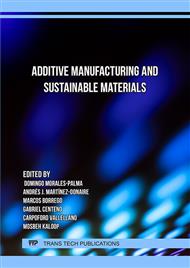p.57
p.67
p.77
p.89
p.97
p.105
p.111
p.119
p.131
Optimization of Sandblasting to Improve the Surface Finish of 17-4PH Parts Manufactured by SLM Using Different Laser Scanning Strategies
Abstract:
Great advances have emerged in recent years around additive manufacturing techniques, with an increasing number of different materials (polymers, ceramics, metals). However, metal part manufacturing has always been one of the most demanded in engineering. That is due to its ability to create final functional parts with good mechanical properties. One of the most widely used technique is Selective Laser Melting (SLM). The SLM process uses a laser power source to selectively melt metal powder layer by layer. Typically, this manufacturing technique requires mechanical post-processing operations, not only to split the parts from the build-plate, but also to improve the mechanical properties and surface finish of parts or the dimensional accuracy of specific regions to ensure assembly and interchangeability. In particular, sandblasting is a method of mechanical abrasion cleaning commonly used and very useful for improving the surface topology of SLM printed parts. Besides, the laser scanning strategy used in this additive manufacturing process influences the surface quality of parts. Therefore, in this work, the sandblasting post-process has been optimized for surface roughness improving in parts printed using the most common laser scanning strategies (normal, hexagonal, concentric). The role that sandblasting pressure and time plays in the surface quality of parts, indispensable to optimize this SLM post-process, has been evaluated. Thus, surface roughness of different specimens subjected to different sandblasting parameters has been measured to optimize both values related to the laser scanning strategy used in SLM manufacturing. The material used is 17-4PH stainless steel, an alloy that presents an excellent combination of high strength and good corrosion resistance, high hardness, good thermal properties, as well as excellent mechanical properties at high temperatures. This precipitation-hardened steel has important applications in the aerospace sector, chemical and petrochemical industry, energy sector, surgical instruments, high wear components, and general metallurgy, among others.
Info:
Periodical:
Pages:
97-103
Citation:
Online since:
October 2023
Price:
Сopyright:
© 2023 Trans Tech Publications Ltd. All Rights Reserved
Share:
Citation:



